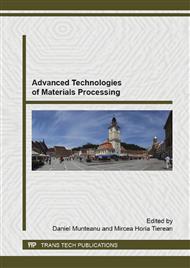p.3
p.10
p.18
p.26
p.35
p.44
p.51
p.58
Pores Size Influence on the Permeability for Copper Foams
Abstract:
In the paper are presented the techniques for obtaining metallic foams based on copper. The permeability of them is described. The metal foams in this case are made from a mixture of copper and NaCl in well-established proportions (20%, 30% and 40% Cu), pressed (the mixture) in mould and sintered at temperatures of 780°C and 830°C. Proper knowledge’s of the permeability (K) are important and should be defined properly [1]. The present study was carried out to have an understanding the influence of different permeability values for different NaCl concentrations in the foams. The necessary equipment was adapted for this purpose. The permeability values obtained for this reason was correlated with the pore size and number of pores per square centimeter. With the increasing of pore diameters and copper proportion the increasing of permeability of metallic foams was also measured.
Info:
Periodical:
Pages:
3-9
Citation:
Online since:
October 2015
Authors:
Keywords:
Price:
Сopyright:
© 2015 Trans Tech Publications Ltd. All Rights Reserved
Share:
Citation:


